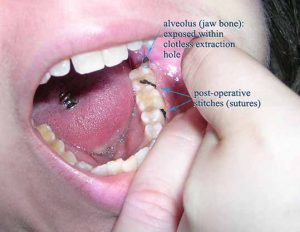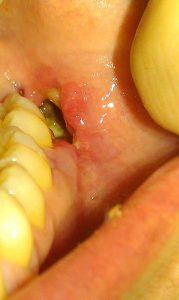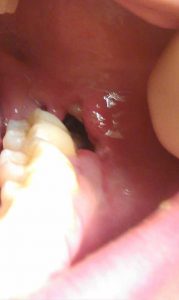Table of Contents
What Is A Dry Socket?
A dry socket (medically termed alveolar osteitis) is a painful dental condition (complication) that sometimes occurs after an adult tooth extraction.
Dry socket occurs when the blood clots fail to develop at the site of tooth extraction. Even it occurs if the blood clot dislodges or dissolves before the tooth extraction wound is healed.
Usually, blood clots form at the site of tooth extraction as a protective layer. That prevents infections, facilitates healing, and supports soft tissue growth in the empty socket.
After tooth extraction, the socket becomes empty. Therefore, the nerves and underlying structures must be protected. The body’s defense mechanism uses blood clots as a protective mechanism.
If the underlying nerves and bones are not covered, that causes extreme pain. The pain can radiate to other parts of your mouth. The pain increases as the food particles are stuck there.
The dry socket pain usually develops after 2 to 3 days of tooth extraction.
A dry socket is the most common and most painful complication of tooth extraction. Only over-the-counter pain killers cannot relieve the pain of a dry socket. Instead, the dentist provides a course of treatment to cure the dry socket.
Let’s dive deep into dry sockets and more.
Dry Socket Symptoms
The sign and symptoms are sometimes can be confused with other types of dental pain or conditions. The history of the patient is important for diagnosis. A tooth extraction within a week can be helpful.
The sign and symptoms of dry socket may include;
- Extensive pain within a few days of a tooth extraction
- Loss of blood clots at the tooth extraction site. Sometimes that is visible in naked-eye
- Pain radiates to the ear, eye, temple, or neck at the same side of the tooth extraction
- Bones are visible at the socket
- Halitosis (bad or unusual breath)
- Unusual and unpleasant taste in the mouth.
The pain usually occurs after two days of tooth extraction and first radiates to the ear.
Emergency Situations
Some pain after a tooth extraction procedure is normal. However, that pain should be relieved by over-the-counter pain medications prescribed by the doctor.
If your pain becomes more intense over time, you should contact your doctor.
Also, if you notice any of the signs and symptoms mentioned above, contact your dentist as soon as possible.
Tests For Diagnosis of Dry Socket
- Dental x-ray (common)
- Blood tests (rare)
- Antibiotic resistance test (rare)
Read Dental Surgery | Gum Graft Surgery
Dry Socket Causes
There are some common causes of a dry socket that may include;
- Bacterial contamination in the socket
- Trauma at the site of tooth extraction. Usually, it happens in wisdom tooth extraction.
Dry socket causes are still a matter of study. However, researchers are trying to find out the exact causes for dry sockets.
Risk Factors of Dry Socket
There is not enough data about the cause of the dry socket. However, researchers found out some risk factors of it. People with these risk factors are more prone to dry sockets than others.
Risk factors of the dry socket are;
- Smoking and tobacco – a piece of cigarette contain more than 5000 chemicals. They may contaminate the site and reduce the healing speed. Sucking action can also play a role here.
Tobacco is also responsible for cancer and other mouth disease and conditions.
- Oral contraceptives or estrogen replacement therapy – oral contraceptives contain estrogen. That can hinder the healing process.
Estrogen replacement therapy plays an important role in hindering the blood clotting process.
- Poor oral hygiene – The dentist provides some instructions after a tooth extraction surgery. The patient should follow those instructions to avoid certain complications. Poor oral hygiene helps to survive the bacterias inside your mouth.
- Dry socket history – If you ever suffered from dry socket in the past, your possibility to experience dry socket is much folds higher than others.
- Wisdom tooth – If your wisdom tooth is extracted, you have to maintain some extra care because the wisdom tooth socket has the incidence of dry socket more than other teeth.
- Teeth or gum infection – If you have teeth or gum infection that is not treated, then you are at the risk zone. Your doctor may recommend you to treat the infection of teeth or gum before performing a tooth extraction procedure.
Usually, the root canal is done when the roots of the teeth are affected. Antibiotic oral wash is also used as dental prophylaxis to eliminate the colony of bacterias.
- You should avoid using straw within some days of tooth extraction. The sucking mechanism may facilitate the premature dislodgement of the blood clot.
Dry Socket Treatment
In dentistry, the main concern is to eliminate the pain, and the only way to do that is to eliminate the reason that is causing the pain.
The course of treatment
- Flushing the socket to remove the food particles and other substances
- Dressing the socket to avoid further interruptions
- Prescribing over-the-counter NSAIDs (pain medications) such as paracetamol.
The treatment process doesn’t end at the hospital. The patient has to maintain some instructions to avoid dry sockets until total healing.
Steps of home treatment
- Using special antibiotic mouthwash to rinse your mouth
- Taking the pain medications regularly
- Brushing and flossing with extra care regularly
- Try not to chew any food on the side of the mouth affected.
The dentist may ask you for a follow-up visit to evaluate the progress and ensure the healing process is completed.
Recovery of Dry Socket
Generally, a dry socket takes about seven days to get recovered. Although, you may need to wait some more days to get fully recovered from the dry socket.
You have to maintain a hygienic lifestyle to avoid any further complications.
Your dentist’s instruction for proper healing may include;
- Avoid smoking and chewing tobacco
- Rinsing the mouth with mouth wash or warm salt water as the doctor advised
- Brushing and flossing with extra care
- Drinking more liquid than solid
- Avoid chewing on the affected side of the mouth
- Avoid cold water and carbonated beverage
- Avoid cold compression in the cheek, as the doctor advised
Complications
Dry socket complications are quite rare. Although the potential complications of a dry socket may include;
- Delayed healing
- Infection to site
- If the infection is untreated, it may lead to chronic bone infection (osteomyelitis)
- Bad breath
Dry Socket Prevention
Prevention is better than cure. If you maintain optimum oral health, the risks of dry sockets reduce by many folds.
Steps To Take Before The Surgery
- Consult with an experienced dental surgeon for tooth extraction.
- Avoid smoking and chewing tobacco at least one or two weeks before tooth extraction. This helps the most to prevent dry socket and oral infections.
- Consult with your doctor about your drug history and previous medical history. Don’t skip any medications that you are taking or taken for a while.
- Follow every instruction recommended by the doctor for safe and effective surgery.
Steps That Your Dental Surgeon Would follow
The dentist follows some steps to get the best result and prevent complications.
These steps may include;
- Using antibacterial mouth wash before and after the surgery
- Antibiotic treatment if you are prone to infection or you are at risk of potential infection
- Antiseptic may be applied to your wound after tooth extraction
- Proper dressing after the tooth extraction is done.
The dental surgeon makes sure they have taken all the precautions to prevent every possible complication. The rest is in your hand.
Steps To Take After The Surgery
After the surgery, your doctor will give you some instructions to follow during the recovery period. Following those instructions properly not only facilitates your healing process but also prevents potential complications.
After tooth extraction, you are prone to infection until the healing is done. So make sure you are doing everything advised by the doctor to prevent infections.
Post-surgery instructions for preventing dry socket may include;
- Modifying activity – You may have to modify your daily activity until the healing process is done. Avoiding extreme physical activity, exercise and sports may be advised.
- Pain management – Your dental surgeon will prescribe you some pain medications. He may also advise you to rinse your mouth with some warm saltwater. Cold compression on the cheek may also work.
- Drink enough water – Drink enough water is essential to prevent dry sockets. Avoid alcohol, caffeinated, and carbonated beverage. Drink plain water. Avoid using a straw. Sucking action facilitates the premature dislodgement of the blood clot.
- Food – eat soft foods during the first week after the surgery. Too hot food should not be an option. Hard foods can worsen the condition. While chewing the food, make sure you are chewing on the other side of your mouth.
- Tobacco – Already mentioned earlier, avoiding tobacco prevents dry sockets and many other oral diseases and other organ diseases. Sucking action during smoking is also responsible for dry sockets.
Oral Hygiene To Prevent Dry Socket
Oral hygiene is important to prevent dry sockets and other oral conditions. Brushing and flossing should be a routine. Brushing twice a day is mandatory.
Avoid brushing the tooth extraction site for the first day. While brushing the teeth, take extra care until the healing process is done.
Rinse your mouth with warm salt water at least twice a day. The traditional method is to add half a tablespoon of salt to one glass of warm water.
If your doctor advises you on antibacterial mouthwash, use it by reading the instruction manual.
Visit your dentist for dental prophylaxis at least once every six months to prevent potential oral conditions.
How Common is Dry Socket?
A dry socket is the major complication of tooth extraction, and it’s quite rare.
According to a study, the risk of dry socket after a tooth extraction is 1.8%.
More specifically, if you are extracting a wisdom tooth, more chances than other teeth to get affected.
Dry socket is painful yet easy to treat. So do not hesitate to contact your dentist if you feel anything unusual after tooth extraction.
Pictures of Dry Socket





Dry Socket Summery
A dry socket is a complication of tooth extraction. It occurs if the blood clot fails to develop, dislodge or dissolve in the empty socket before the healing process is done.
The causes of the dry socket are many. The symptoms include extreme pain after one or two days of tooth extraction. Bad breath can also occur.
Talk to your doctor if you experience any of the symptoms of dry socket.
Frequently Asked Questions (FAQs)
What does a dry socket look like?
Dry sockets can be diagnosed by naked eye examination. You can see there isn’t any blood clot in the empty socket and the internal structures are quite visible. See the pictures of the dry socket for a better understanding.
When can I stop worrying about dry sockets?
You can stop worrying about dry sockets after the tooth extraction healing process is done. The pain of the dry socket begins about one or two days after the tooth extraction. And it takes about a week to get fully recovered from a tooth extraction. So, if you can maintain proper oral hygiene and the instructions of your doctor, you can stop worrying about dry sockets after a week.
How to prevent dry sockets?
Avoid smoking, maintain proper oral hygiene, follow the instructions provided by the doctor. Take some extra care during brushing and flossing. Surely, you can prevent dry sockets by taking these preventive measures.
How long does the dry socket last?
It depends on your dry socket condition. It recovered completely after one or two weeks from the day of treatment starting.
How to avoid dry sockets?
Follow the instructions provided by the doctor after a tooth extraction surgery. Take some preventive measures and modify your lifestyle positively.
What does a dry socket feel like?
The dry socket is extremely painful. The pain started to occur one or two days following a tooth extraction surgery. The pain will be more intense if you extracted a wisdom tooth.
How to treat dry sockets?
Consult with a dentist. he will clean the food particles lodged in the empty socket and wash the area with antibacterial mouth wash. The proper dressing will be done. The doctor may prescribe you some pain medications and antibiotics. If there is any sign of infection, the doctor may take some extra care. You have to follow some instructions at home also advised by the doctor.
How do I know if I have a dry socket?
The dry socket is very painful. The pain will occur one or two days after a tooth extraction procedure. You may also experience bad breath. Bones and internal structure can be seen by naked eyes. The pain may also radiate to the ear, temple, or neck of the same side.
What causes dry socket?
The causes of dry sockets are still a matter of research. Infections, smoking, not following post-surgical instructions are common causes.
How to smoke after tooth extraction without getting a dry socket?
Smoking is strongly prohibited after a tooth extraction surgery. There is no way you can smoke after tooth extraction without getting a dry socket.
Last Updated on February 23, 2022 by Learn From Doctor Team





